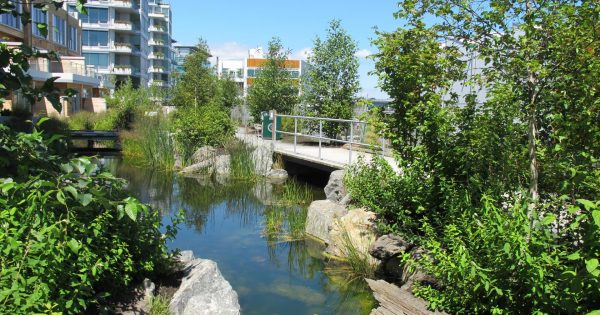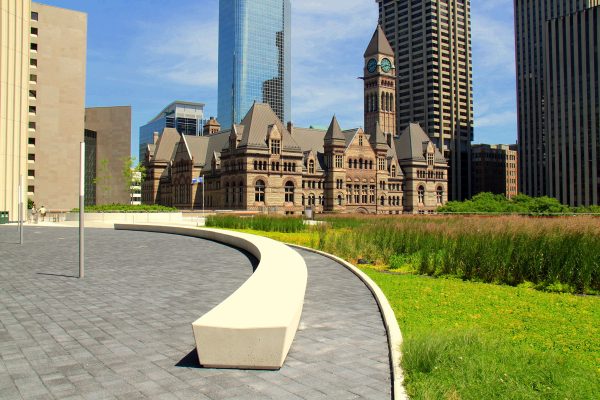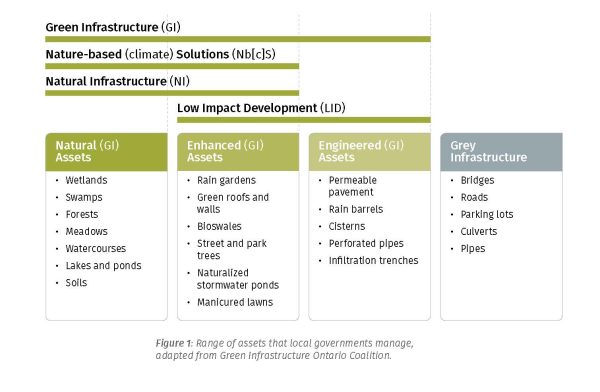Carolyn Whitzman is a senior research associate with the Canadian Urban Institute and Roy Brooke is the Executive Director of the Natural Assets Initiative
The next generation of Canadian affordable housing developments should preserve and enhance natural assets, according to a new report from the Natural Assets Initiative and the Canadian Urban Institute.
Natural assets are features of an ecosystem that provide, or could be restored to provide, essential services and benefits to Canadians. Especially in times of increased climate-related risks of fires and floods, the environmental and economic benefits of carbon sequestration through woodlands, and flood regulation and nutrient recycling through wetlands should inform how and where new housing is developed. The need to preserve and enhance parks and waterways — nature in the city — for physical and mental health is especially acute if we intensify housing close to public transit and services.
Since the 1990s, the Canada Mortgage and Housing Corporation has acknowledged that restrictive municipal zoning and approvals processes which do not consider the full lifecycle costs of infrastructure have been fuelling suburban and regional sprawl, worsening greenhouse gas (GHG) emissions, and destroying irreplaceable natural resources.
Built-up areas of cities are already serviced by physical infrastructure such as water and sewer lines and public transit, as well as social infrastructure, including schools, recreation centres and hospitals. However, populations in the most built-up areas of cities have declined over the past 50 years, due to smaller households, an aging society, rooming houses conversions, and increasingly restrictive planning rules.
The federal government has recently stepped up its efforts to address the national shortage of affordable and well-located housing supply across Canada, with a plan to more than double home production to 3.87 million new homes by 2031. This agenda includes a renewed interest in using government land for homes — one of the mechanisms that helped enable the development of thousands of post-Second World War Victory Houses as well as innovative mixed-income developments such as St. Lawrence Neighbourhood in the 1970s.
Through the Housing Accelerator Fund, the federal government is already pursuing conditional infrastructure agreements linked to relaxed restrictive zoning. It is now providing further funding for public transit, water and waste infrastructure to provinces and territories, in return for freezes on development charge increases and the implementation of natural Homeowner and Renter Bills of Rights.
Other countries show how to provide social and environmental benefits through strong government leadership. Singapore, for example, has pursued integrated planning co-benefits of affordable housing supply within a ‘city of nature’ since independence in 1964. The Housing Development Board has developed over a million homes, accounting for 80 percent of the homes in a city-state of 5.5 million people. The emphasis has been on limited equity home ownership, with government control over sale and resale prices.
This approach has paid off: in 2021/22, typical prices for a one-bedroom home ranged from $95,000 to $234,000 CAD, and for a four-bedroom from $372,000 to $525,000. At the same time, Singapore has developed a network of 7,800 hectares of green space, connected by 370 hectares of park connectors. The housing itself is actively planted with 300 hectares of ‘skyway greenery’ like landscaping on roofs and walls.
The re-naturalization of existing water and land assets is ongoing, with the state converting concrete canals into naturalized rivers, and building new reservoirs that serve as naturalized lakes to catch and retain rainwater. These natural systems support rich biodiversity, including the return of formerly endangered species. They also protect nearby homes from the risk of flooding brought about by climate change.
The City of Paris increased its proportion of non-market housing from 16 percent in 2009 to 24 percent in 2022, with over 75,000 new non-market homes aimed at low and moderate-income households, as well as 35,000 acquired from the private sector. The municipality’s focus is on underutilized sites, such as former office and commercial spaces and parking lots, and on refurbishment, rather than demolition, of existing public housing, a choice that reduces carbon emissions and tenant displacement.
Paris’ strong emphasis on environmental justice underscores the simultaneous prioritization of sustainable transit, affordable housing, and natural asset management. In response to recent fatal heat domes, Paris has planted hundreds of ‘green oases’ in the past decade, starting with school yards. The target is that no Parisian will live more than seven minutes from a shaded park by 2030. It achieved a target of building 30 hectares of new parks, mini-forests and community gardens between 2014 and 2020, many in the courtyards of new housing developments. The buildings themselves have up to 200 hectares of green roofs, with green walls (using clinging vines such as ivy) helping to cool the buildings as well.
In Canada, developments such as Dockside Green, in Victoria, B.C., have encouraged environmental innovation through a ‘sandbox, not staightjacket’ outlook. The City took a ‘performance-based’ approach to rezoning the formerly industrial site, doubling the residential density immediately and then trading off further density for environmental performance. A blue spine of interconnected wetland ponds, with native plantings and re-introduced local fish, anchors the development, acting as wastewater treatment as well as amenity and community gathering space.
This green/blue infrastructure more than pays for itself, with the wastewater treatment plant recovering stormwater, sewage, bathwater, and dishwater, thereby exempting residents from fees assessed to pay for a new citywide sewage system. Treated water is looped back into buildings to flush toilets and irrigate site landscaping. An additional 68,000 litres of treated water is sold to nearby industrial users.

Iy’álmexw, or Jericho Lands as it is more commonly known, is an even more ambitious project, with at least 13,000 homes planned on 36 hectares (90 acres) in Vancouver. The site is being jointly developed by the Musqueam, Squamish, and Tsleil-Waututh Nations (MST Partnership) and Canada Lands Corporation, on a former Department of National Defence site.
The MST Partnership wanted to start with the existing natural systems and design around them. Significant trees and key habitats that enrich the ecology of the site and provide natural carbon capture and storage will be kept and connected to adjacent parks, naturally managed areas and open spaces. Changing climate conditions are being considered with the plans calling for “clean air shelters” in community spaces — a recognition of the increased frequency and severity of forest fires, and reuse of rainwater for most non-potable uses.
The natural assets report provides recommendations to the federal government, including mapping and costing the value of services from existing and potential natural assets on federal land suitable for housing, and developing precinct master plans that preserve and enhance these assets through the creation of new urban parks, forests, and wetlands alongside higher-density housing.
Finally, infrastructure agreements with municipalities and provinces should prioritize the retention of existing natural assets and development of new enhanced ones. As part of negotiations over federal lands, local First Nations must be included as full partners from the outset, prioritizing co-development and land back models.
Carolyn Whitzman is a housing policy researcher and senior research associate with the Canadian Urban Institute. She is the author of the forthcoming Home Truths: Fixing Canada’s Housing Crisis (UBC/ On Point Press, 2024).
Roy Brooke is the Executive Director of the Natural Assets Initiative. He has worked in Canada, Europe and Africa in urban sustainability, national politics, international development and humanitarian affairs.





